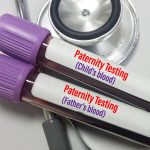It might be beneficial to both pregnant parents to know who the true father of the unborn child is. Pregnancy-related paternity tests can ease anxieties and facilitate parent-child bonding. However, many people are curious about the alternatives and how early you can do a DNA test during pregnancy or on an unborn baby. This article will discuss where to obtain prenatal paternity testing, the precision of tests, and the earliest possible time to establish paternity before delivery. For a thorough overview of DNA testing while pregnant, continue reading. Whether you want to determine paternity as promptly as possible or have inquiries regarding the procedure and timeline is relevant.
Can a paternity test be done during pregnancy?
It is possible to do paternity tests while pregnant to ascertain whether a guy is the unborn child’s genetic father. The most reliable methods for determining paternity before childbirth are chorionic villus sampling (CVS) and amniocentesis. Amniocentesis is typically carried out around weeks 15 to 20. However, CVS can be started as early as weeks 10 or 13. In both methods, a tissue specimen from the placenta or amniotic fluid containing fetal DNA is obtained using a tiny needle. After that, the possible father’s DNA is analyzed to determine if it matches the biological father. The accuracy of the tests is over 99%. Conversely, because they are surgical procedures, there exists a low chance of miscarriage. Although there are Non invasive prenatal paternity test that use the mother’s blood, they are less reliable until much later in the gestational period.
How to get a DNA test while pregnant?
In the face of the new technological development, we must seize the opportunity to know whether our emotional attachments are directed towards and invested in the rightful owner. Knowing the truth before investing in our feelings and emotions in someone who might not be their rightful recipient. Taking a Prenatal Paternity Test can solve all these problems and clear doubts to strengthen your relationship with the coming baby. Some of the Prenatal Paternity tests and their procedures are:
Chorionic villus sampling CVS
Chorionic villus sampling is known as CVS. This prenatal test involves removing a tiny sample of tissue called the chorionic villi from the placenta and examining it for chromosomal anomalies and genetic illnesses. It is usually carried out during weeks ten and thirteen of gestation. The chorionic villi, which resemble tiny fingers of placental tissue, are made of the same genetic material as the developing fetus. Testing for further genetic abnormalities and illnesses could be possible.
Amniocentesis
One prenatal procedure called amniocentesis looks for any genetic problems and anomalies by analyzing the amniotic fluid around the fetus.
Additionally, amniocentesis makes DNA available for paternity testing before birth. The prospective father’s DNA is extracted and compared to the baby’s DNA taken during amniocentesis. In terms of establishing paternity, the results are 99% correct.
Non-Invasive Prenatal Paternity Testing (NIPP):
Using accurate NIPP testing. Without risking termination, expectant mothers send a simple blood sample obtained by their doctor for examination using its proprietary techniques.
The mother’s bloodstream mixes and circulates with the DNA of the unborn child throughout pregnancy. It is necessary to separate and examine fetal DNA strands from the overwhelming amount of maternal DNA to determine paternity early on.
How Long Does a DNA Test Take?
The complexity of the case and the type of DNA testing service you require will determine how long DNA testing takes. The goal of DNA testing is to return the results to you as soon as feasible. Most of the time, you can anticipate receiving your findings from our laboratory in 3-5 business days after the samples are submitted.
An extended DNA marker test in cases that are more complicated, such as when the two putative dads are brothers. As you might anticipate, this DNA test will examine more DNA markers than would typically be required to get a definitive and accurate result, which could take longer than if the two putative dads were unrelated.
Do you need the father for DNA testing?
DNA testing can be used to determine paternity without the father’s presence. In the event that the father is unavailable, there are two choices:
Grandparent DNA test: This matches the child’s DNA to that of the father’s paternal grandparents. There is going to be common DNA among a grandparent and grandchild that can be examined to estimate a relationship because grandparents pass on half of their DNA to their offspring. In the event that the putative father is unavailable for testing, this can aid in establishing paternity.
Sibling DNA Test: The child’s DNA can be compared to that of any more kids, like half-siblings that the purported father may have. Roughly 50% of the DNA is in full siblings and roughly 25% in half-siblings.
DNA test while pregnant at home?
Indeed, non-invasive prenatal paternity testing, or NIPP testing, can be used to determine paternity during pregnancy. This examines fetal DNA found in the mother’s bloodstream throughout her pregnancy.
This is how it operates:
A basic blood sample is obtained from the expectant mother.
A lab that specializes in NIPP testing receives the material.
From the mother’s blood, laboratory personnel separate the fragments of fetal DNA.
Next, the fetal DNA is genotyped and contrasted with a sample of the purported father’s DNA.
Paternity can be proven with a high degree of precision, usually greater than 99% if the fetal DNA matches the purported father’s DNA. The primary benefit of NIPP testing is that the fetus is not at risk, and it is a non-invasive procedure.Unlock the Secrets of Your DNA with Our Testing Services

Conclusion
Early paternity discovery during pregnancy might help expectant parents mentally and practically prepare. There are untested and unreliable at-home or non-medical techniques for identifying the father during pregnancy. Prenatal DNA testing with reputed DNA testing facilities like Choice DNA provides alternatives that are accessible for findings that are precise and conclusive. Testing in the first half of the second trimester offers the optimum combination of security, precision, and prompt timing. Choosing when and what kind of prenatal paternity testing to have done is a personal choice; however, consulting a doctor is advised. Understanding the hazards and limits is crucial if testing is pursued as soon as feasible. Prenatal paternity testing offers pregnant parents the information and comfort they need concerning the baby’s genetic father despite several limitations.



















